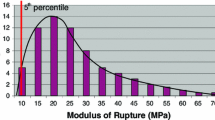Summary
The techniques of kriging and trend removal analysis for modeling the strength properties of lumber have been discussed. Using these techniques, the within member compressive strengths of 38 mm × 89 mm 2100f-1.8E and the within member tensile strengths of 38 mm × 89 mm No. 2 spruce-pine-fir lumber have been modeled. The suitability of these techniques to model the strength properties of lumber has been evaluated by comparing the kriged compressive and tensile strength data to baseline experimentally collected compressive strength data and simulated tensile strength data, respectively. Comparisons of the results of statistical analyses of the baseline data and the kriged data show good agreement. The use of kriging and trend removal techniques to generate strength values in simulation studies for finite element analyses of wood structures is judged to be effective.
Similar content being viewed by others
References
Foschi, R. O. 1977a: Analysis of wood diaphragms and trusses. Part I: Diaphragms. Canad. J. Civil Eng. 4:345–352
Foschi, R. O. 1977b: Analysis of wood diaphragms and trusses. Part I: Truss-plate connections. Canad. J. Civil Eng. 4:353–362
Foschi, R. O. 1982: Structural analysis of wood floor systems. J. Struct. Div. Amer. Soc. Civil Eng. 108:1557–1574
Foschi, R. O.; Barrett, J. D. 1980: Glued-laminated beam strength: a model. J. Struct. Div. Amer. Soc. Civil Eng. 106:1735–1754
Lam, F.; Varo lu, E. 1991a: Variation of tensile strength along the length of lumber — Part I: Experimental. Wood Sci. Technol. 25:351–359
Lam, F.; Varo lu, E. 1991b: Variation of tensile strength along the length of lumber — Part II: Model development and verification. Wood Sci. Technol. 25:449–458
Kline, D. E.; Woeste, F. E.; Bendtsen, B. A. 1986: Stochastic model for modulus of elasticity of lumber. Wood Fiber Sci. 18:228–238
Krige, D. G. 1951: A statistical approach to some basic mine valuation problems on the Witwatersrand. J. Chem. Metallurg. Mining Soc. of South Africa 52:119–139
Showalter, K. L.; Woeste, F. E.; Bendtsen, B. A. 1987: Effect of length on tensile strength of structural lumber. U.S. Dept. of Agric. For. Serv. For. Prod. Lab. Res. Paper FPL-RP-482. Madison, WI., U.S.
Xiong, P. 1991: Modeling strength and stiffness of glued-laminated timber using machine stress sated lumber. Thesis of M.Sc., Dept. of Forestry, Univ. of British Columbia.
Author information
Authors and Affiliations
Rights and permissions
About this article
Cite this article
Lam, F., Barrett, J.D. Modeling lumber strength spatial variation using trend removal and kriging analyses. Wood Sci.Technol. 26, 369–381 (1992). https://doi.org/10.1007/BF00226078
Received:
Issue Date:
DOI: https://doi.org/10.1007/BF00226078




